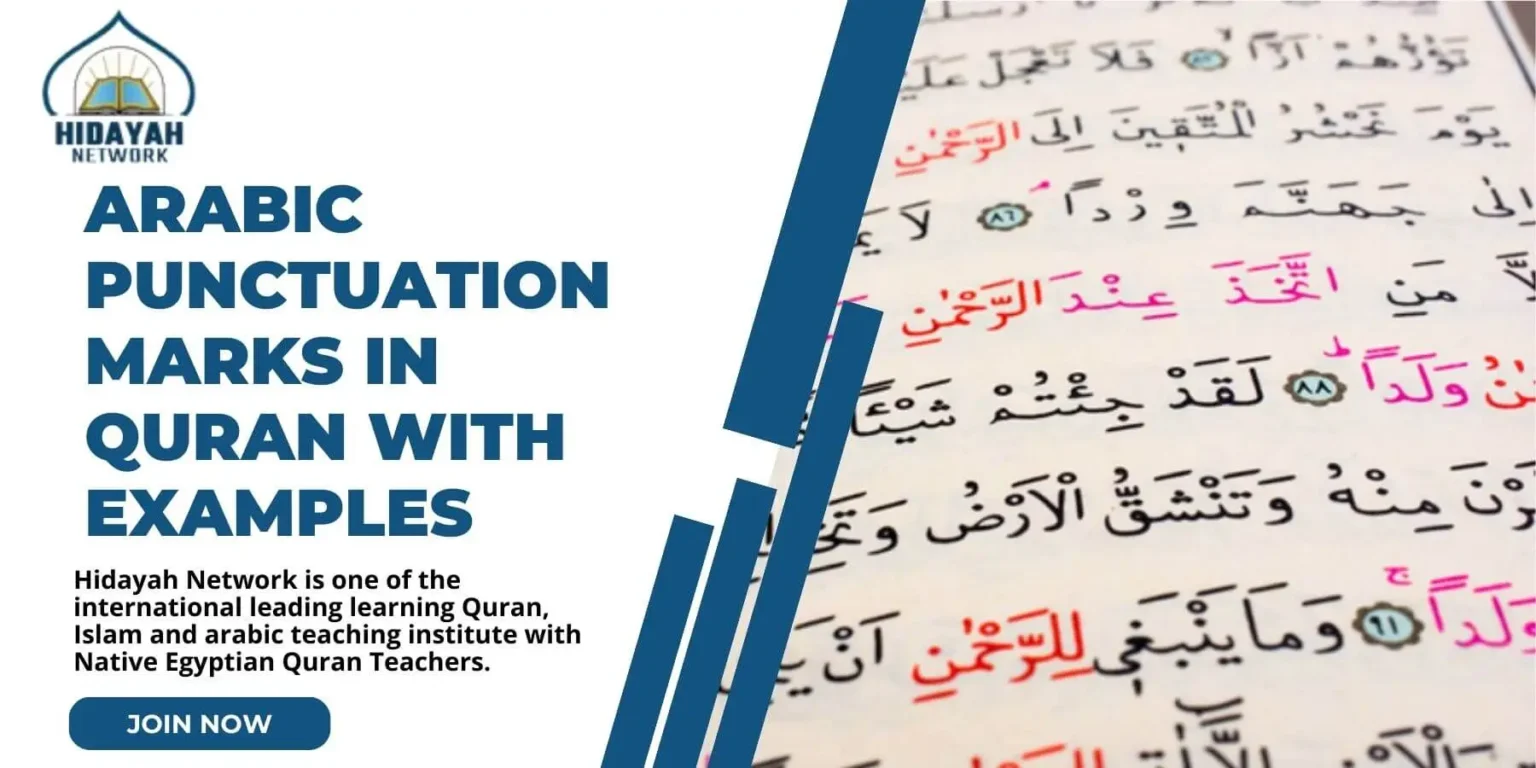Arabic Punctuation Marks in Quran

- Hidayah
- Network
- | Role: Hidayah Network

The Quran, the holy book of Islam, is filled with wisdom and guidance for millions around the world. Have you ever wondered why there are those little dots and symbols in the Quran? Well, those are Arabic Punctuation Marks, and they are like road signs for reading the Quran! They help us pause at the right places, understand the meaning better, and even know when to bow in prayer.
Let’s meet some of these marks: the Full Stop, the Mandatory Pauses like م (m) and ط (ṭ), and the Discretionary Pauses like ج (j) and ص (ṣ). They might seem small, but each one has a big job in making sure we recite quran perfectly. So, let’s get started and explore these punctuation marks together!
Table of Contents
ToggleWhat are the Arabic Punctuation Marks in Quran?
Arabic Punctuation Marks in Quran are like little helpers in the Quran. They tell us when to pause, stop, or keep going. These marks are also called rules of stopping in quran. For example, the Full Stop () tells us it’s the end of a sentence. There are also Mandatory Pauses like م (m) and ط (ṭ), which are super important. They make sure we don’t change the meaning of what we’re reading.
Then, we have Discretionary Pauses like ج (j) and ص (ṣ), which are like suggestions for when to take a breath or pause if we need to. These marks might seem small, but they’re big helpers when we read the Quran!
1. Punctuation Marks
Full Stop (): This mark signifies the complete end of a verse. After this mark, the last letter loses its vowel if a consonant or converts the tanwin into an elongated alif if an alif’s tanwin.
- Example: اقْرَأْ بِاسْمِ رَبِّكَ الَّذِي خَلَقَ (1:1) (Read in the name of your Lord who created)
Signs of Pause (وقف) (waqf)
Mandatory Pauses (Waqe e Lazim): Stopping at these points is obligatory during recitation.
م (m): Abbreviation for “lazim” (necessary). Disregarding this sign can alter the meaning.
- Example: وَلَا الضَّالِّينَ (1:7) (And not of those who go astray) – Stopping here emphasizes the distinction between those who are guided and those who are not.
ط (ṭ): Abbreviation for “mutlaq” (absolute). It indicates a full stop even though the verse is not complete.
- Example: كذلك يضرب الله الأمثال للناس لعلهم يتذكرون (14:25) (Thus does Allah set forth parables for the people that they may take admonition) – Stopping here creates a pause before the explanation of the parables.
لا (la): “No” in Arabic. It signifies a forbidden stop. The reciter should continue if encountered except at the verse’s end.
- Example: قُلْ هُوَ اللَّهُ أَحَدٌ (112:1) (Say, “He is Allah, [who is] One”) – Stopping anywhere else disrupts the declaration of God’s oneness.
س (s) or سكتة (skt): Abbreviation for “sukut” (silence). It indicates a short pause without breathing out.
- Example: الْحَمْدُ لِلَّهِ رَبِّ الْعَالَمِينَ (1:2) (All praise is due to Allah, Lord of the worlds) – A slight pause here emphasizes the universality of Allah’s dominion.
وقفة (wqf) or وقف (wqf): Similar to “sakt” but with a slightly longer pause.
- Example: الرَّحْمَنِ الرَّحِيمِ (1:3) (The Most Merciful, the Most Compassionate) – A longer pause here highlights the divine attributes of mercy and compassion.
Note: The tutors at Hidayah Network online quran recitation course provide instruction on Arabic punctuation marks to their students.
Get 40% OFF Now!
2. Discretionary Pauses
Stopping at these points is up to the reciter’s discretion based on meaning and breath control.
ج (j): ” جائز” (ja’iz), meaning permitted. It indicates a recommended stopping point, but the reciter can continue if needed.
- Example: الَّذِينَ آمَنُوا وَعَمِلُوا الصَّالِحَاتِ (2:2) (Who have believed and done righteous deeds) – Pausing here allows the reciter to reflect on the qualities of believers.
ز (z): “مجوز” (mujawwaz), meaning also permitted. It suggests it’s better not to stop at this point.
- Example: وَأَقِيمُوا الصَّلاةَ وَآتُوا الزَّكَاةَ (2:43) (And establish prayer and give zakah) – Continuing without pause emphasizes the connection between these two pillars of Islam.
ص (ṣ): “مرخص” (murakhkhaṣ), meaning permissible to stop. It indicates a place where stopping is allowed, especially if the reciter is tired.
- Example: وَلَا تَقْتُلُوا النَّفْسَ الَّتِي حَرَّمَ اللَّهُ إِلَّا بِالْحَقِّ (6:151) (And do not kill the soul which Allah has forbidden, except by right) – Pausing here allows for contemplation on the sanctity of life.
ق (q): “قيل عليه الوقف” (qila `alayhi al-waqf), meaning it has been said to pause here. It indicates a place where some scholars recommend stopping, but others recommend continuing.
- Example: وَلِلَّهِ الْمَشْرِقُ وَالْمَغْرِبُ (2:115) (And to Allah belongs the east and the west) – Pausing here can emphasize God’s dominion over all directions.
قف (qf): “يوقف عليه” (yuwaqafa `alayhi), meaning it is better to stop here. This indicates a strong recommendation to pause for better understanding of the verse.
- Example: فَإِنَّ اللَّهَ غَفُورٌ رَّحِيمٌ (2:186) (Then indeed, Allah is Forgiving, Merciful) – Pausing here allows the listener to absorb the message of God’s forgiveness and mercy.
صل (ṣl): “قد يوصل” (qad yuwasal), meaning it can be connected. This indicates the majority view is to pause, but some scholars consider continuing permissible.
- Example: وَلَا تُشْرِكْ بِي شَيْئًا (19:40) (And do not associate with Me [anything] as an associate) – Pausing here emphasizes the importance of monotheism, but continuing can highlight the following explanation of what not to associate.
◌ۗ: ” الوقف أولى” (al-waqf awla), meaning stopping is better. This indicates a recommended pause for clarity.
- Example: قُلْ هُوَ اللَّهُ الصَّمَدُ (112:2) (Say, “He is Allah, the Self-Sufficient”) – Pausing here separates the declaration of God’s oneness from His attribute of self-sufficiency.
◌ۖ: “الوصل أولى” (al-wasl awla), meaning connecting is better. This indicates a recommended continuation for smoother flow.
- Example: هُوَ الَّذِي أَنْزَلَ عَلَيْكَ الْكِتَابَ (2:1) (It is He who has sent down to you the Book) – Continuing here emphasizes the connection between God and the revelation of the Quran.
◌ۛ (Mganqah): These three dots, appearing together, are called “Mganqah” signs, meaning “hugging.” They indicate a place where the reciter can choose one of the dots to pause.
- Example: (Example for Mganqah can vary depending on the specific Quran with these markings. Here’s a general example): فَإِنَّ اللَّهَ قَرِيبٌ بَصِيرٌ (4:149) (Then indeed, Allah is Near, Seeing)
Marginal Marks: These marks show divisions within the Quran.
- Chapters (Surah): The Quran has 114 chapters, each with a distinct name and varying lengths. Verses (ayah) are numbered within each chapter.
- Sections (Ruku’): A chapter may be divided into sections (ruku’) indicated by the letter ع (ayn). These divisions help with pacing during recitation.
- Juz’ (جزء): The Quran is divided into 30 equal parts (juz’) for those who wish to recite it in portions over a set time. The starting point of each juz’ is marked at the margin.
- Hizb (حزب): Each juz’ is further divided into 60 parts (hizb). Three different hizb signs are used in the margin to indicate the quarter of the juz’ completed:
- الربع (ar-ribo): The first quarter.
- النصف (an-nisf): The half.
- الثلٰثة (ath-thilatha) – Abbreviation of ثلٰثة ارباع (thlathutha arbaa): The last quarter.
- Prostration (sajdah): The word “السجدة” (as-sajdah) written in the margin or next to a verse indicates a place where Muslims reciting or listening should perform a prostration. There are 14 such verses in the Quran.
3. Additional Marginal Marks
These marks are specific to Quran editions in the Indian subcontinent and indicate variations in pausing practices.
- : This symbol indicates a difference of opinion on the pausing point among scholars.
- وقف النبي (Waqf an-Nabi): Pause of the Prophet, indicating a point where the Prophet Muhammad (PBUH) is reported to have paused during recitation.
- وقف مّنزَّل and وقف جبريل (Waqf Munazzal & Waqf Jibril): These terms signify pauses attributed to the Prophet’s angel of revelation, Gabriel (AS).
- وقف غفران (Waqf Ghifran): Pause of forgiveness, indicating a point where pausing is believed to bring forgiveness.
- وقف كفران (Waqf Kufran): Pause of disbelief, indicating a point where pausing is considered undesirable.
Who Added Arabic Punctuation Marks in Quran?
The need for Arabic Punctuation Marks arose because early Quranic manuscripts were written without vowels or diacritical marks, making it challenging to read and understand. Abd al-Malik, the Umayyad caliph, recognized this challenge, and under his reign, Abu’l Aswad al-Du’ali introduced the system of large colored dots (tashkil).
These dots helped clarify pronunciation and meaning, aiding readers in proper recitation. This fundamental reform was crucial for preserving the Quran’s integrity and ensuring accurate recitation. It was a significant step towards standardizing the text and making it accessible to a wider audience. With the help of these punctuation marks people started. understand rules to read quran.
Final Words
Arabic Punctuation Marks in the Quran are essential guides for readers to learn to read the quran, helping with pauses, pronunciation, and understanding. From the Full Stop indicating the end of sentences to the Mandatory and Discretionary Pauses guiding recitation, each mark plays a crucial role. Today, these marks continue to be invaluable, ensuring that the Quran’s message is conveyed with clarity and precision, guiding millions in their study and recitation of this revered scripture.

About Author
